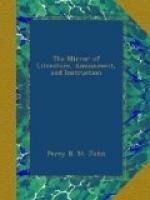* * * * *
INDIAN CORN.
The most valuable article in South American agriculture, is unquestionably the maize, or Indian corn, which is cultivated with nearly uniform success in every part of the republic. It appears to be a true American grain, notwithstanding many crude conjectures to the contrary. Sometimes it has been known to yield, in hot and humid regions, 800 fold; fertile lands return from 300 to 400; and a return of 130 to 150 fold is considered bad—the least fertile soils giving 60 to 80. The maize forms the great bulk of food of the inhabitants, as well as of the domestic animals; hence the dreadful consequences of a failure of this crop. It is eaten either in the form of unfermented bread or tortillas (a sort of bannock, as it is called in Scotland;) and, reduced to flour, is mingled with water, forming either atolle or various kinds of chicha. Maize will yield, in very favourable situations, two or three crops per year; though it is but seldom that more than one is gathered.
The introduction of wheat is said to have been owing to the accidental discovery, by a negro slave of Cortez, of three or four grains, among some rice which had been issued to the soldiers. About the year 1530, these grains were sown; and from this insignificant source has flowed all the enormous produce of the upper lands of Mexico. Water is the only element necessary to ensure success to the Mexican wheat grower; but it is very difficult to attain this—and irrigation affords the most steady supply.
Ibid.
* * * * *
THE AGAVE AMERICANA.
On Maguey, is an object of great value in the table land of the interior of Mexico; from this plant is obtained the favourite liquor, the pulque. At the moment of efflorescence, the flower stalk is extirpated, and the juice destined to form the fruit flows into the cavity thus produced, and is taken out two or three times a day for four or five months; each day’s produce is fermented for ten or fifteen days; after which the pulque is fit to drink, and before it has travelled in skins, it is a very pleasant, refreshing liquor, to which the Mexicans ascribe as many good qualities as the Highlander does to whiskey. The stems of the maguey can supply the place of hemp, and may be converted into paper. The prickles too are used as pins by the Indians.—Ibid.




